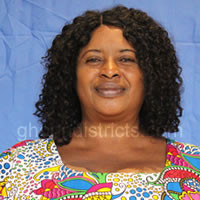Main Source of Water for Drinking and other Domestic uses
The major sources of water for drinking by households in the District are pipe-borne (outside dwelling, public tap/standpipe) and bore hole/tube well and river/stream. These sources of water for drinking accounts for 88 percent of households in the District. Table 8.10 shows the source of water that households drink or use for other domestic purposes in the District and that of the country and Region. The analysis revealed that a total of 47.2 percent of the households in the District drink pipe-borne water including water from stand pipes. In addition, 28.7 percent of the households obtain drinking water from bore holes and protected wells. Table 8.10 also shows that 21.8 percent of households obtain drinking water from unprotected sources such as springs, wells, rivers/streams, ponds, lakes and dams and so on.
Main source of water for other domestic use
Further analysis of the data in Table 8.10 indicates that, 41.5 percent of the households use pipe-borne water inside and outside dwelling and public tap/standpipe for other domestic purposes. In terms of locality of residence, the proportion of households that obtain pipe-borne water inside and outside dwelling and public tap/standpipe for other domestic uses is higher in urban (58.2%) than rural areas (33.2%). However, households that use boreholes for domestic purposes constitute 28.1 percent in rural areas compared to 17.4 percent for urban localities.
Slightly over one-third (30.6%) of households in the District use water from unprotected sources including wells, springs, rivers, lake, dams, ponds and so on as shown on Table 8.10. It is worthy to note that the potable water situation is generally better in the urban than rural areas.
Bathing and Toilet Facilities
Table 8.11 presents information on the type of toilet and bathing facilities used by households in the District. The data shows that nearly one out of five (19.8%) households in the District have no access to toilet facilities and therefore, resort to defecation indiscriminately. The data further shows that, about 35.3 percent of the households use public toilet and a negligible proportion use bucket or pan latrine (0.3%). For households with toilet facilities, it is shown that a low proportion use water closet (1.3%), about 31.4 percent use pit latrine and 11.5 percent use KVIP.
There is slight deviation between rural and urban areas in terms of access to toilet facilities. A higher proportion of households in rural (37.7%) than urban areas (19.1%) use pit latrine whiles higher percentage of households in urban (44.9%) than rural areas (30.4%) use public toilet (WC/KVIP/Pit Pan and so on). Again, it emerged from the analysis that one out of every five households (20.7%) in rural areas is without access to toilet facility relative to 17.9 percent in urban areas.
Bathing facilities
Table 8.11 indicates that the use of own bathroom exclusively for bathing constitute the highest proportion of households bathing facility in the District (35.6%), followed by shared bathroom in the same house (26.4%). However, a total of 13.7 percent of the households share open cubicle for bathing. Private open cubicle, open space around house, river/pond/lake/dam, public bathhouse, bathroom in another house and open space around house are used by relatively lower proportions of households in the Biakoye District.
There are variations between rural and urban areas in terms of the proportion of households using own bathroom exclusively, shared separate bathroom in same house and private open cubicle. The rural areas have higher proportion of households using their own bathroom exclusively (39.5%) than urban households (27.9%). On the other hand, high proportion of urban households use shared open cubicle (25.4%) as bathing facility than their rural counterparts (7.7%).
Date Created : 11/17/2017 7:35:26 AM



